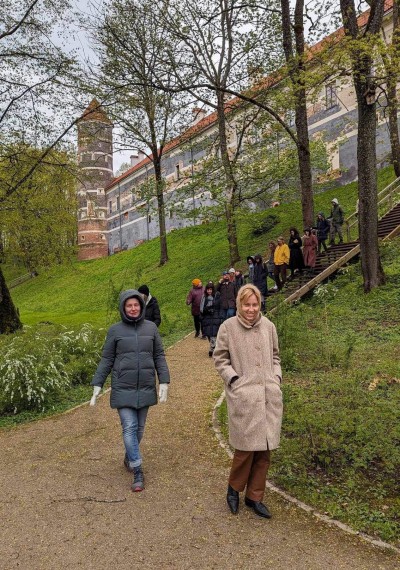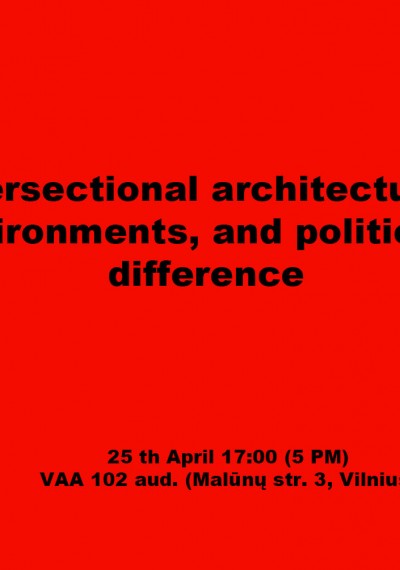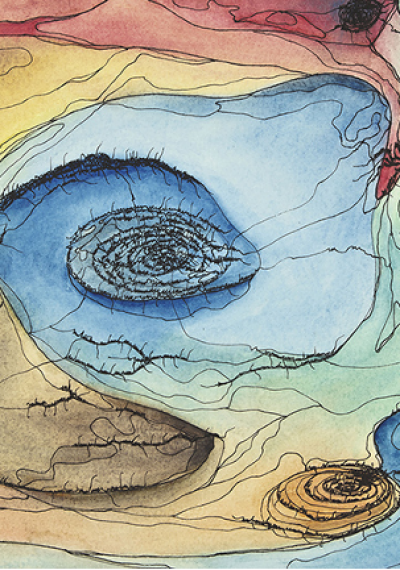Since mid-May, Vilnius Academy of Arts (VAA) the Nida Art Colony (NAC) outside territory has started to reshape itself. Among other works in progress, the first steps were implemented to develop a public wild plant garden. In parallel artist Žilvinas Landzbergas is working on a public sculpture and NAC has launched a new research and residency programme Neringa Forest Architecture Residency based on spatial and material processes developed to investigate the forest as infrastructure.
Public Sculpture by Žilvinas Landzbergas
In May 2020 artist, VAA professor and frequent guest at NAC Žilvinas Landzbergas began realisation of a public sculpture, situated in the northern part of the NAC public territory. The work redesigns and reformulates current patterns of the social use of the space defined by the fireplace, and opens up this part of the NAC public space to the garden of Eduardas Jonušas House and the public path close by. The sculpture has been developed throughout 2019; we are happy to have entered now the final phase: the realisation of this work.
Thanks to Landzberga’s sincere analysis of the surrounding space of the NAC, this project became a catalyst to jointly focus, rethink, and plan the general impression of this space. Since the construction of the NAC buildings in 2011 and 2016, the territory surrounding them was left somewhat undefined and anonymous. We realised that shaping and defining functions of each of the areas of the territory became mandatory in order to actually be able to develop and situate a sculpture somewhere, and in order for the sculpture to be able to perform, instead of disappearing in the context of a parking lot and a general feeling of indifference of this space. For this reason, together with architect Povilas Marozas and ecological landscape designer and botanist Vilma Gudynienė, a plan was developed that included a general redesign and shaping of the green areas of the NAC territory. This process went hand in hand with the planning of Landzberga’s sculpture.
Landzbergas is working on a composition of various concrete and ceramic sculptures. Large concrete pedestals in abstract and concrete shapes of various heights are organised around a custom made fire bowl. The sculptural ensemble gives this social context a new look, creating a well structured space that is inviting and allows one to literally encounter the NAC public space from new perspectives. The concrete pedestals can be used as plateaus to rest and sit, as tables, or as bars to support the organisation of social gatherings. Surrounding trees were shaped and integrated in the setting thus giving the possibility to rest in the shade. During the course of the summer the now rough pedestals will be finalised and ceramic sculptures produced and added.
The first phase of the works were finalized in May in collaboration with Martynas Maziliauskas and Martynas Margevičius. We look very much forward to the finalisation of this process. In the meantime, the NAC guests and visitors are welcome to inhabit the pedestals, and to use, improvise, and generate their own social setups based on their needs.
About Žilvinas Landzbergas
Studied sculpture at Vilnius Academy of Arts and completed the De Ateliers postgraduate course in Amsterdam. From 2011 to 2013 he co-ran an independent project space in Vilnius called Malonioji 6. Landzbergas represented Lithuania at the 57th Venice Biennale with the installation R. His work has been presented in a number of international group exhibitions including RIBOCA 1 (2018), About the Trees at the Zentrum Paul Klee, Bern (2016), and City Without Walls: Vilnius at the Liverpool Biennial (2010), among others. In 2016 Landzbergas received the Neringa Municipality Stipend and was a board member of NAC from 2014–2019. Landzbergas curates, lectures, and often engages collaborative practices into his larger scale works.
The project is co-funded by Neringa Municipality.
NAC Wild Plant Garden
Since mid-May 2020, the NAC outside territory has started to reshape itself. Among other works in progress, the first steps were implemented to develop a garden –– two gardens, actually. One is designed for wild plants, bushes, and trees that grow in the Curonian Spit National Park; the other part consists of all types of productive plants brought to NAC in exchange or as presents by NAC neighbours, guests, local inhabitants, and extended families as a continuous process.
The goal of reshaping the outside territory around NAC (which currently can be described as an indifferent and anonymous parking lot) is to materialise and reflect in areal design the processes that take place inside of the institution: research, production, and education within the fields of visual arts, architecture, design, and culture as well as humanities and social sciences. As a public space, the new design should be insightful and smart in terms of sustainability of concept, materials used, and plants selected, but also comfortable and pleasant as surroundings. Wild perennial garden design has a positive effect on biodiversity by restoring links between organisms –– sustainability becomes the starting point for assessing the perception of our living environment.
The use of local resources has been a central element of this process. The general strategy for reorganisation of the green areas of the outside territory of NAC was developed and designed by landscape architect Povilas Marozas in close collaboration with NAC director Egija Inzule. Custom seeded flat lawn areas were partly lifted, introducing a relief to the territory. To support the relief, obsolete benches previously used in the Nida town public space were acquired by Komunalninkas (the municipality organisation responsible for designing and upkeeping public spaces in Nida) and reused, applying the same stability system as in Robert Smithson’s artwork Mirrors and Shelly Sand (1969-1970). Already rotten, these benches will disappear over the course of time, while plants will take over the structure and continue forming it themselves. Povilas Marozas sculpted the garden, having in mind compositions and formations he had observed in the Curonian Spit forests, especially paying attention to the moments when the artificial upkeeping of the forests by the Curonian Spit National Park interacts with the existing structure and is made visible.
The composition of local wild plants was defined by the ecological landscape designer and botanist Vilma Gudynienė. The selection was previously discussed and advised with botanists Raimonda Ilginė from the Curonian Spit National Park and Asta Klimienė, director of Botanical Garden of Klaipeda University. Under supervision of the Curonian Spit National Park botanists, the plants were carefully dug out at especially designated locations. Local grasses (šepetukas and šluotsmilgė), mosses, and lichen, wild heather and viola among others were replanted in the NAC backyard. Soil preparation works, gathering, and planting were done in a 7-day joint work action by the NAC team and a group of volunteers: residents at NAC, friends, and supporters as well as Povilas Marozas and Vilma Gudynienė themselves, with their partners and children.
As Vilma Gudynienė says, it will take a while for the plants to accommodate themselves in their new surroundings after this type of “surgery”. The general idea is to let the wild plants design and form this new habitat to make it their own by using time as the main element in forming the garden. The garden will always stay a work in progress, a continuity, and it gives NAC a structure for the possibility to trace back, layer, make visible, and materialise time. This garden is a tool for storytelling of various kinds and a catalyst for historical, geographical, political, folkloristic, and fictional gatherings. Artists and dear friends throughout history are in our minds –– those who have worked on gardens as integral parts of their works, with their monographs to be found over the course of time at the NAC library
Vilma Gudynienė is an ecological landscape designer and botanist. Her practice is based on the usage of local (wild) plants, which works as both the means to preserve and shape the identity of the particular landscape and a way to enrich biodiversity in the urban areas. As a natural scientist, Gudynienė evaluates and faces ongoing changes in the wild. She actively applies and implements her professional knowledge in various fields, such as strategic assessment of greenery ecosystems and biodiversity, general and dendrological analysis of greenery, the providing of recommendations for the management of urban green spaces.
Povilas Marozas is a landscape architect, Chartered Member of the Landscape Institute (CMLI), and certified as Greenery Project Manager in Lithuania. He studied architecture at Vilnius Gediminas Technical University and architectural history at Bartlett School of Architecture (University College London) in London. Marozas started his career in landscape architecture in London, where he spent over 8 years working for numerous international landscape practices, such as Vogt Landscape, Djao-Rakitine, and Periscope. Throughout this period he developed high profile public realm and landscape projects in the UK, Europe, Russia, and Middle East.
NAC would like to thank the Kuršių Nerija National Park team and director Aušra Feser, the Neringos Komunalininkas team and director Danguolė Šešelskytė, Asta Klimienė and Raimonda Ilginė for their advice and support. Thanks to residents at NAC for their restless work and energy: Milda Zabarauskaitė and Robertas Narkus, Jurga Daubaraitė and Jonas Žukauskas, Lina Lapelytė and Mantas Petraitis, Kamilė Levulė and Rudolfas Levulis; thanks to Aistė Balčaitė, Donatas Baltrušaitis, Agnė Dailidaitė, Indrė Dikavičiūtė, Sandra Dumčiūtė, Gerda G. Šeirė, Daura Polonskytė and the team of Zuikio daržas. NAC would like to especially thank Žilvinas Landzbergas for his strategic support and for inviting Povilas Marozas and Vilma Gudynienė to this project.
The project is co-funded by Neringa Lithuanian Capital of Culture 2021 and Neringa Municipality.
Neringa Forest Architecture: Residency, Research and Study Programme
NAC has developed a new research and residency programme based on spatial and material processes. Neringa Forest Architecture Residency takes the forest as the centre of the cultural landscape – a site where the material cycle of growing, harvesting, natural drying, and processing of timber will become the basis of a residency and research programme.
As scholars and architects of the 2019 Neringa Scholarship, Jurga Daubaraitė and Jonas Žukauskas started their project Forest Parts, seeking to open up opportunities for the various institutions operating in the Curonian Spit to collaborate and combine their activities with art, design, and research practices. As a further step in this process, together with NAC director Egija Inzule they initiated a new residency and research programme to take place in 2020–2022. This programme takes the Curonian Spit’s forests as a case study to conjoin to the deeper analysis in the wider context of infrastructure of forests in the Baltic-Scandinavian region: their natural growth and change, policy making, forestry management processes, timber technology, and design innovations.
The material cycle of locally grown wood will become the basis of the programme. Neringa Forest Architecture Residency will assemble local and international experts, scholars, designers, architects, artists as well as students and faculty of Vilnius Academy of Arts to initiate design propositions. The accumulative timber material resource and technological base will allow design and production of objects from local wood, emphasising collaboration with local institutions.
Neringa Forest Architecture Residency started with cutting a pile of wood into planks, specifically, 25m3 of logs, felled in the Curonian Spit forests during the last logging season (November 2019 – February 2020) and acquired by NAC from Kretinga Forestry, the institution in charge of logging in the spit. From March through May 2020, these logs were stored in the front yard of the NAC. In May, a mobile sawmill cut them into planks of various sizes and thicknesses. Continuing this process, the NAC front yard in the upcoming summer months will partly be used as a public workshop and timber storage. Architects are currently working on developing a storage structure that will enable the timber material to be stored and naturally seasoned on site.
As cultural practitioners, we perceive the forest as an active construction site and a material resource – a harvested area that is simultaneously protected, cultivated, simulated, and managed. In the Neringa Forest Architecture Residency, the forest links the local spatial practices of the Curonian Spit with an international discourse and network of design and architecture professionals as a landscape and material resource. Utilizing the unique qualities of local wood will combine local and international practices, thereby re-opening Neringa as an authentic space of ideas – the project will articulate the relationship of forest as cultural infrastructure with the public thus creating the material culture of the future.
Forest parts. The Pine Sample.
Installed in the public space in Nida, close to Thomas Mann House, The Pine Sample informs the general public and gives an overview about the historical and current processes of the formation of the landscape of the Curonian Spit. The Pine Sample comes from the Grobštas nature reserve at the Lithuanian - Russian border where in 2019, Curonian Spit National Park foresters cleared self-planted, 30-40 year old pines to open up the dunes from overgrowth. The pine was carefully dug out by hand in November 2019 to keep its root system as intact as possible. The pine’s structure is revealed by a longitudinal cut from the apex to its roots, where among grooves, the seed from which the tree grew is visible. You can download here a pdf combining text and images of The Pine Sample.
Jurga Daubaraitė and Jonas Žukauskas are a duo of spatial practitioners currently based in Vilnius. Through architectural, curatorial and research projects they aim to create new relations between societies and their environment, past and future, by seeking to rearticulate architecture across a wider ecology of practices. They curated the exhibition The Baltic Material Assemblies at AA Gallery and RIBA in London (2018), and were co-curators of The Baltic Pavilion at the 15th International Architecture Exhibition at Venice Biennale (2016), and co-editors of The Baltic Atlas published by Sternberg (2016). Currently Daubaraitė and Žukauskas are working on Creative Playground and Garden in Vilnius and are developing the Neringa Forest Architecture Residency programme with Timber Material Cycle at NAC.
NAC would like to thank the Curonian Spit National Park team, especially Gražina Žemaitienė and director Aušra Feser, the Neringos Komunalininkas team and director Danguolė Seselskytė for their advice and production support. Nida and Juodkrantė foresters: Kęstutis Dikšas, Romas Andrusevičius, Viktoras Kolokšanskis.
Neringa Forest Architecture Residency is co-funded by Neringa Lithuanian Capital of Culture 2021 and Nordic Culture Point. Forest Parts is co-funded by Neringa Municipality.











